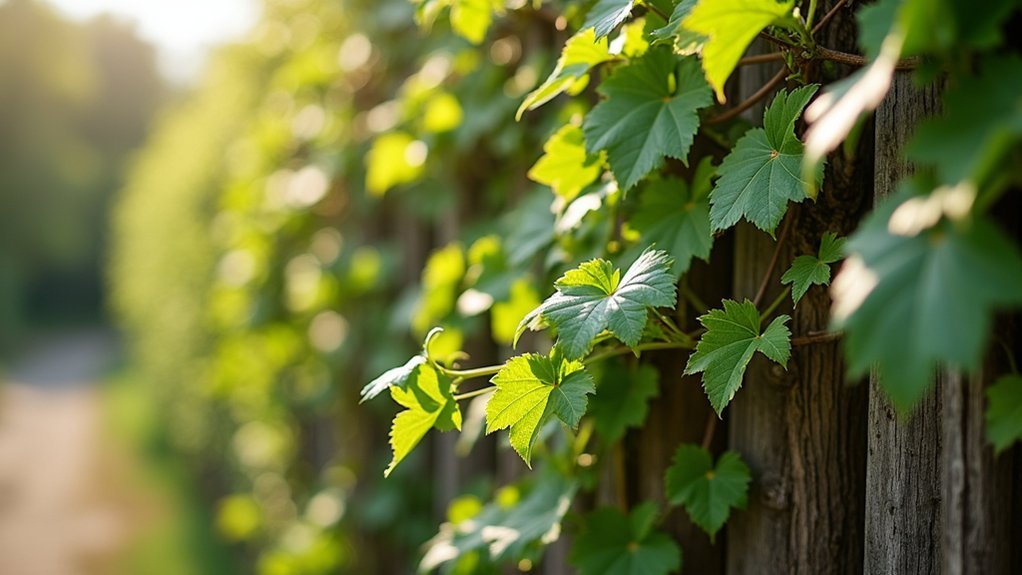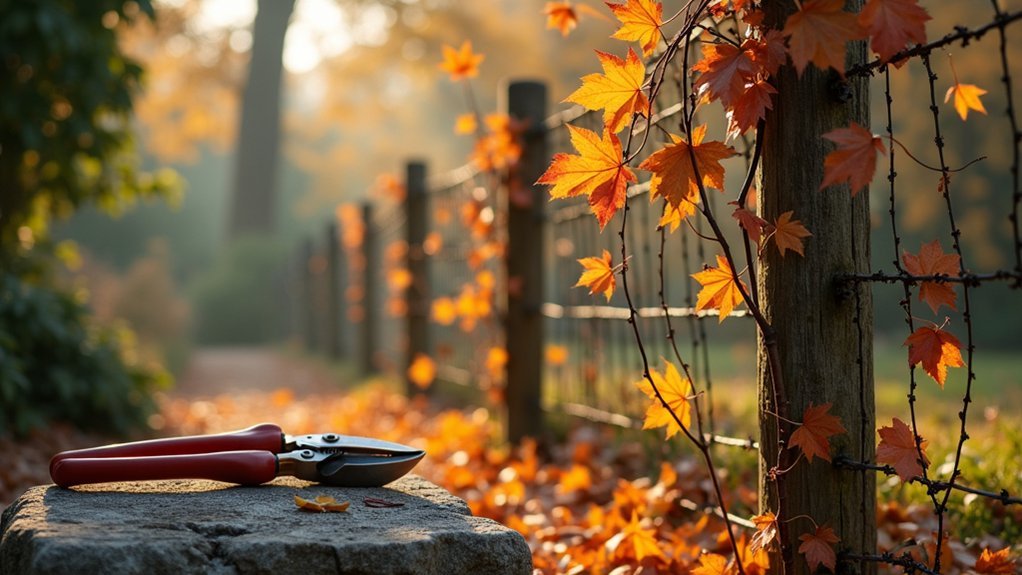Maintain your vine fence year-round by pruning in spring to control growth patterns and improve airflow. Water deeply in summer, reinforcing supports as vines gain weight. Clean up debris in fall and prepare vines for dormancy by trimming one-third of growth. Protect delicate species in winter from snow and ice damage. Inspect weekly for pests, using organic solutions when needed. Apply appropriate fertilizers seasonally. Check structural supports regularly to prevent fence damage. These simple practices guarantee beautiful, healthy vines for years to come.
Spring Pruning to Control Vine Growth Patterns

While winter’s grip loosens, spring emerges as the perfect time to tackle your vine maintenance. Before the growing season fully begins, grab your pruning shears and focus on controlling how your vines grow along your fence.
Start by identifying and removing dead or damaged branches that survived winter. This targeted pruning helps maintain a healthy vine structure while preventing overgrowth that could potentially damage your fence.
You’ll also improve air circulation around your plants, which greatly reduces disease risk and keeps pest infestations at bay.
Annual spring pruning isn’t just about containment—it enhances flowering and fruiting in many vine species. By managing vine size early in the season, you’re setting up your garden for a more vibrant display while ensuring your fence remains both functional and beautiful.
Summer Watering and Support Reinforcement
As temperatures soar during summer months, your vine-covered fence requires special attention to thrive through the heat. Deep watering is vital—provide 1-2 inches weekly to promote healthy root development and robust growth.
Summer heat demands vigilant care for fence vines—deep watering ensures roots thrive despite scorching temperatures.
Don’t forget to regularly inspect and reinforce support structures. Trellises and wires must withstand the increasing weight of vigorous summer vines.
Apply mulch around the base of your plants to retain soil moisture and keep unwelcome weeds at bay.
Weekly pest checks are essential as warmer weather intensifies insect activity. Catch problems early to prevent extensive damage.
Consider light pruning in early summer to encourage bushier growth and improve air circulation between vines. This simple step greatly reduces the risk of fungal diseases that flourish in humid conditions.
Fall Cleanup and Preparing Vines for Dormancy

As temperatures drop, you’ll need to prune dead growth from your vine fence, removing weak branches and crossed stems that won’t survive winter.
Secure any vulnerable stems that have loosened during summer growth by gently reattaching them to your support structure using soft garden ties.
This targeted pruning and securing work prepares your vines for dormancy while preserving the strongest growth for next season’s display.
Pruning Dead Growth
Grab your pruning shears as autumn leaves begin to fall—it’s time for essential vine maintenance. Removing dead and diseased growth prevents pest infestations during winter dormancy while promoting healthy regrowth when spring arrives.
Aim to trim back approximately one-third of the total vine growth, focusing on leggy or overgrown sections. This strategic pruning improves air circulation throughout your fence line, greatly reducing the risk of fungal infections that thrive in dense foliage.
Always use clean, sharp tools when cutting to minimize plant damage and prevent disease transmission between your cherished vines.
After you’ve finished pruning, apply a protective layer of mulch around the base of each plant to retain moisture and regulate soil temperature as your vines enter their dormant period.
Securing Vulnerable Stems
With pruning complete, your attention should now turn to securing exposed vine stems before winter’s arrival. Use soft ties or jute string to attach vulnerable stems to their support structure. This simple step will protect your investment from harsh winds and heavy snow that could otherwise damage your carefully cultivated vines.
Take time to inspect your fence for any signs of damage or weakness that might fail during winter storms. Remove dirt, fallen leaves, and debris from around the base of your vines to prevent moisture buildup and potential rot.
These proactive steps help keep your vine’s health ideal through dormancy. Consider adding a layer of mulch around the base for temperature stabilization. Regular maintenance now means fewer problems later, and your vines will reward you with vigorous spring growth.
Winter Protection Strategies for Delicate Vine Species
When winter’s harsh conditions threaten your delicate vine species, proper protection becomes essential for their survival and future growth. Regularly remove snow and ice from the base of your vines to prevent trapped moisture that leads to root rot.
Guarantee proper drainage around the vine base to avoid water pooling during freeze-thaw cycles.
Ensure soil drains well around vines, preventing damaging water accumulation during winter’s freeze-thaw patterns.
Apply mulch around your vines to provide insulation for the root system while maintaining adequate soil moisture.
For maximum protection of sensitive varieties:
- Wrap vulnerable stems with burlap or frost cloth to shield against biting winds
- Regularly inspect vines for cold damage like cracks or dieback
- Prune back affected areas promptly to encourage healthy spring regrowth
These preventative measures will help your decorative vines weather the coldest months and emerge vibrant when spring arrives.
Managing Pests and Diseases Throughout the Growing Season

Healthy vine fences face constant threats from various pests and diseases that can quickly devastate your living barrier if left unchecked. Regularly inspect your vines for aphids, spider mites, and mealybugs, which can rapidly multiply if not addressed promptly.
When you spot infestations, apply organic insecticidal soaps or neem oil for effective control without harming beneficial insects.
Watch for powdery or downy mildew, which appears as white spots on foliage. Maintain proper air circulation through strategic pruning, removing dead or infected foliage immediately to prevent disease spread.
Your watering routine is equally critical—inconsistent moisture stresses plants, making them susceptible to diseases, while overwatering encourages root rot and attracts pests. Establish a balanced watering schedule that keeps soil consistently moist but never soggy.
Fertilization Timing for Optimal Vine Health
Proper timing of fertilization dramatically impacts the health and vigor of your vine fence throughout the growing season. To achieve ideal vine health, fertilize vines in early spring with a balanced, slow-release fertilizer at approximately 1 pound per 100 square feet. This supports robust growth as they emerge from dormancy without risking over-fertilization damage.
Consider these key timing strategies:
- Apply initial fertilizer in early spring when new growth appears
- Implement mid-summer fertilization to sustain plants during peak growth
- Switch to organic fertilizers like compost or well-rotted manure for improved soil structure
Monitor vine growth regularly and adjust your approach based on plant performance and soil nutrient levels.
Many gardeners find that organic options provide steadier nutrition while enhancing overall soil health, creating a sustainable environment for your vines.
Structural Maintenance for Long-Term Vine Support

The foundation of a thriving vine fence rests on consistent structural maintenance throughout the seasons. As vines along your fence grow and mature, they add weight that can potentially cause structural damage if supports aren’t properly maintained. Regular inspections help identify problems before they worsen.
Ensure all wire supports remain firmly anchored and taut—sagging wires lead to uneven growth and compromise the fence’s integrity. Check for loose screws or rusted components that need immediate attention.
Monitor your trellis regularly for signs of stress, especially after storms or heavy growth periods. Don’t overlook drainage around your fence base; add mulch or gravel to prevent moisture buildup that weakens both the structure and vines.
Trimming back overgrown or dead tendrils prevents excess weight that could strain your support system over time.
Frequently Asked Questions
How Do You Weather Treat a Wood Fence?
You’ll clean the fence thoroughly, let it dry completely, then apply a UV-protective penetrating oil or stain evenly across all surfaces, paying extra attention to moisture-prone areas. Reapply every 1-3 years for continued protection.
How to Keep Vines From Growing on Your Fence?
Install trellises or wire supports to keep vines off your fence. Trim regularly, use garden edgers for root control, and choose annual vines instead of woody species. You’ll prevent damage by maintaining proper boundaries.
How Often Should You Weatherproof a Fence?
You’ll need to weatherproof wooden fences every 1-3 years depending on your climate. Vinyl and aluminum fences require less maintenance, only needing treatment every 5-7 years. Always clean thoroughly before applying any sealants.
How Do I Keep My Wood Fence From Fading?
Apply UV-resistant sealant regularly, clean with low-pressure water, and re-stain every 3-5 years. You’ll also want to tighten loose boards and consider non-moisture-retaining vines to protect your fence from fading.
In Summary
Following these seasonal maintenance tips will keep your vine fence thriving year-round. You’ll enjoy lush growth in summer and protect your investment during winter’s harsh conditions. Remember, consistency is key—don’t skip your seasonal checks and maintenance tasks. With proper care, your living fence won’t just survive but will enhance your landscape’s beauty and privacy for many years to come.





Leave a Reply